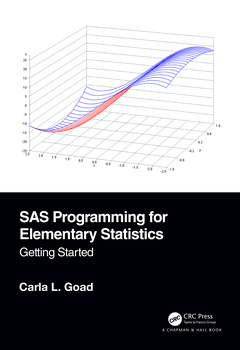Description
SAS Programming for Elementary Statistics
Getting Started
Language: English
Subjects for SAS Programming for Elementary Statistics:
Keywords
SAS Data Set; software; Proc Sort Data; graphics; Proc Print Data; regression; SAS Session; ANOVA; Variable Class; DATA Step; Var Statement; hypothesis test; SAS Program; Young adolescents; Social diversity; Data Set; SAS programming; Proc Sort; Elementary statistics; SAS Statement; SAS Log; PROC FREQ; PROC FREQ DATA; SAS Data; PRINT Procedure; Scatter Plot; SGPLOT Procedure; Group Variable; Model Statement; Temporary SAS Data Set; Html Output; Proc UNIVARIATE Data; SAS Function; Observed Significance Level
Publication date: 12-2020
· 17.8x25.4 cm · Paperback
Publication date: 12-2020
· 17.8x25.4 cm · Hardback
Description
/li>Contents
/li>Biography
/li>
SAS for Elementary Statistics: Getting Started provides an introduction to SAS programming for those who have experience with introductory statistical methods. It is also an excellent programming supplement for an introductory statistics course. It is appropriate for the beginning programmer with no prior SAS experience and the researcher who would like to refresh SAS programming skills. These lessons are those the author has found successful in the classroom. Strengths of this book include the following:
- Examples are easy to follow and understand.
- Chapters have user-friendly text and objectives.
- Each chapter has clear objectives with SAS syntax and output results given.
- Objectives are stated as tasks with detailed step-by-step instructions.
- Programming notes based on the author's experience occur throughout the book.
- The author assists the reader in making sense of the error messages in the SAS log.
- Brief reviews of statistical methods are included in chapters accompanying the corresponding SAS procedures.
- Easy transition from user terminology to SAS terminology is provided.
- The ability to select or suppress results using Output Delivery System (ODS) is made simple.
- Reading and writing to external files are among the most used SAS skills, and these concepts are clearly presented. The IMPORT and EXPORT procedures and ODS are used to accomplish these tasks.
- Statistical Graphics procedures and SAS/GRAPH can be quite challenging to learn, but these are presented in a very achievable format. Basic graph construction is first introduced then readers learn how to add color, pattern, and other enhancements to graphics images.
1. Introduction to SAS Programming Environment
2. DATA Step Information 1
3. Summarizing Data Basics
4. DATA Step Information – 2
5. Beginning Charts
6. One and Two Population Hypothesis Tests about the Means
7. One-way ANOVA Methods, Non-Parametric Methods and Ranking Data
8. Data Step Information 3 - Reading Data Files & Labeling Variables
9. Frequency Analysis
10. Summarizing a Data Table in a Formal Report
11. Regression and Correlation Analysis
12. SAS Libraries and Permanent SAS Data Sets
13. DATA Step Information 4 – SAS Probability Functions
14. Reading and Writing Data Files
15. DATA Step Information 5 - DO Loops, Arrays, and Random Number Generation
16. Statistical Graphics Procedures
17. SAS/GRAPH Procedures
18. Formatting Responses
19. Output Delivery System (ODS)
20. Miscellaneous Topics
Carla L. Goad is a Professor of Statistics at Oklahoma State University. She holds a Ph.D. in Statistics from Kansas State University. SAS Programming has been an integral part of her work since the late 1980's. She has been teaching an introductory SAS programming course and SAS applications in graduate statistical methods courses since the mid 1990's. Her areas of expertise are experimental design and analysis and linear models. She is a statistical consultant for the Oklahoma Agriculture Experiment Station and has enjoyed working with agricultural researchers in animal and plant sciences. Through these collaborations she has coauthored many articles in agriculture research journals.




